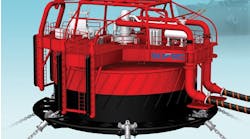Transfer system offers option for standing personnel
Crew logistics is inherent to all offshore operations, with the safety and well-being of personnel directly impacting the success of a project. Marine transfer is becoming increasingly due to the attendant safety and cost-efficiency benefits. A study by DNV GL reveals a lower risk of fatality using marine-based methods of transfer compared with aviation. Crane-based transfer can be used as a primary means or a back-up option to other transfer methods, such as walk-to-work or aviation.
For over 20 years, Reflex Marine has been providing transfer solutions to the offshore industry. For clients operating in challenging offshore environments, the company’s FROG-XT range provides extensive protection against four key risks associated with personnel transfer by crane: falling, vertical impact, lateral impact and immersion. The security provided by the suspension system enables increased operating limits, resulting in higher workability and less downtime while waiting for more favorable transfer conditions.
Some clients also prefer the option of standing rather than sitting during transfer, areas where conditions are sufficiently benign for this operation not to compromise safety. Standing transfers are prevalent in certain regions and some users are accustomed to it. Reflex’s latest innovation, WAVE-4, was designed to offer a safer alternative to current methods and is the first transfer carrier for standing passengers that addresses the four risks listed above.
High costs are a common complaint among owners of existing standby devices. WAVE-4’s simplified inspection and maintenance schedule is designed to limit cost, and all maintenance can be performed offshore, reducing product downtime.




